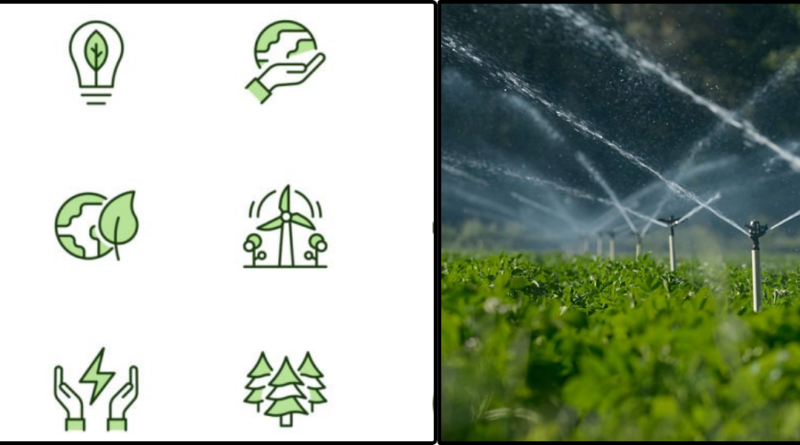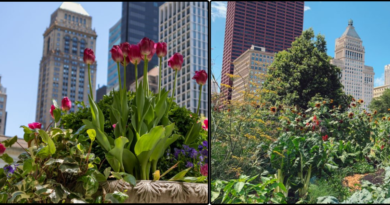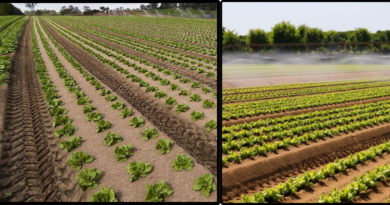Practices for Organic Farming and Water Conservation
Introduction:
Welcome to GreenHealings.com, where our mission is to cultivate a greener, healthier planet through sustainable living practices. We’ll dive into the complex world of organic farming and water conservation in this extensive book, where we’ll examine best practices that protect our valuable water supplies while simultaneously nourishing the soil.

Crop Rotation:
The foundation of sustainable agriculture Mindful Consumption: Choosing Sustainable Products for a Healthier Future is crop rotation, which is more than simply an agricultural custom. We can improve soil fertility and lower the danger of pests and illnesses by deliberately rotating the crops grown on the same plot of land. By encouraging a healthy soil structure, this technique maximizes water retention for long-term crop development.
Cover Cropping:
Planting cover crops in between primary crops provides the land with a natural defense system. This method improves soil fertility while preventing erosion, compaction, and weed development. The end outcome is improved capacity to cling onto water and a robust soil structure that allows crops to stay healthy throughout the year.
Drip Irrigation:
For water-conscious farmers, a precise and effective water distribution system is revolutionary. Water resources are conserved by minimizing waste and reducing weed development through direct water delivery to plant roots. Water consumption is optimized for a better crop output using this strategy, which makes sure every drop counts.
Composting:
Composting: Creating nutrient-rich compost out of manure, agricultural remaining food, and kitchen trash is an easy yet effective method. By enriching the soil and promoting microbial activity, this organic gold helps the soil retain water. Composting helps us become less dependent on artificial fertilizers, which leads to a more environmentally friendly and water-smart farming method.
Rainwater Harvesting:
Rainwater collection is evidence of the wisdom that comes from nature. During dry seasons, gathering rainwater in barrels or reservoirs provides an additional supply of water. We reduce reliance on conventional water sources by using rainwater, which encourages self-sufficiency in water management.
Mulching:
The use of organic mulch around plants provides a multifaceted approach to conserving water. Mulch not only insulates the soil but also inhibits the growth of weeds, decreasing competition for water. By reducing temperature fluctuations and evaporation, this insulation keeps our crops at the ideal moisture content.
Integrated Pest Management (IPM):
Adopting Integrated Pest Management (IPM) signals a change in the way pests are managed. We preserve the quality of our water as well as our crops by taking a comprehensive strategy that promotes natural predators and reduces the need for artificial pesticides. When we put a high priority on living in harmony with nature, the environment benefits more.
Agroforestry Systems:

A creative strategy for sustainable agriculture is to include trees in the agricultural landscape. In addition to decreasing water evaporation and offering shade to the crops below, trees function as natural shields. Their root systems strengthen the structure of the soil, which helps the soil retain more water. Agroforestry methods promote biodiversity in addition to helping crops.
Precision Agriculture:
Precision agriculture,Sustainable Agriculture through Robotics and Automation which integrates technology into farming methods, is a ground-breaking move toward water optimization. Farmers are able to make educated judgments because of the real-time data on moisture levels and nutrient content that soil sensors offer. With this accuracy, water is used effectively, reducing waste and enhancing crop health.
Community Engagement:
We at GreenHealings.com think that communities coming together for the same goal may be powerful. Interacting with neighboring communities and other farms encourages a group commitment to environmentally friendly methods. We increase the effectiveness of these best practices by exchanging information and insights and pushing for more widespread adoption of water-conscious farming.
Organic Pest Repellents:
To preserve your crops without harming the environment or the quality of the water, embrace nature’s natural insect repellents. Companion planting is a well-tried organic technique in which specific plants are produced to discourage pests. Furthermore, natural compounds such as garlic spray and neem oil serve as efficient insect deterrents, negating the need for chemical treatments that can damage the safety of the water supply.
Smart Irrigation Scheduling:
Use technology to improve irrigation techniques by carefully planning your schedule. Farmers may maximize irrigation scheduling by taking weather forecasts, soil moisture content, and crop water requirements into account. Water waste may be reduced and overwatering can be avoided with the use of smart irrigation controllers, which provide precise water application.
Vermicomposting:
Introduce vermicompostinghttps://en.wikipedia.org/wiki/Vermicompost into your organic farming routine. Worms break down organic matter, creating nutrient-rich vermicompost. This natural fertilizer improves soil structure and water retention. Vermicomposting is a sustainable way to recycle kitchen waste while promoting a healthy soil ecosystem.
Renewable Energy Integration:
Investigate integrating sustainable energy sources into your farm. For instance, solar-powered irrigation systems help with energy-efficient water management in addition to lowering your carbon footprint. Organic farming and sustainable energy techniques complement each other, resulting in a comprehensive approach to environmental stewardship.
Rain Gardens:
Design your farm with rain gardens in mind. These spaces were created especially to collect and control runoff from rain. You may reduce soil erosion and promote groundwater recharge by planting native, water-absorbing plants in these specified areas, which will help to create a more sustainable water cycle.
Soil Conservation Terracing:
The application of soil conservation Terracing is a useful approach in steep or sloping terrain. By implementing stepped levels on the ground, this technique lowers water flow and stops soil erosion. Terracing ensures that the soil stays rich and fruitful by promoting improved water absorption and retention by slowing down water flow.
Soil Moisture Management:
An essential component of farming with water conservation is controlling soil moisture. Farmers may further improve water-use efficiency by modifying irrigation schedules according to plant development phases. By ensuring that crops receive the appropriate quantity of water at the appropriate time, these tactics help to create stronger, healthier plants.
Conclusion:
There are a lot of opportunities for sustainable practices in the ever-evolving fields of organic farming and water conservation. GreenHealings.com invites you to consider these best practices as linked strategies rather than discrete methods for a future of farming that is more resilient and environmentally friendly. We create the conditions for a cooperative relationship between agriculture and the environment by continuously inventing and adapting. Let’s work together to leave a sustainable legacy for future generations.





Pingback: Blockchain Revolution: Organic Agriculture Transparency..